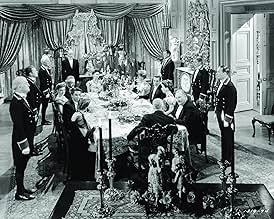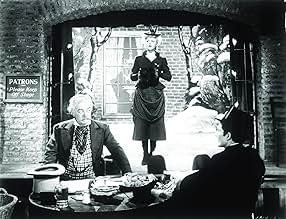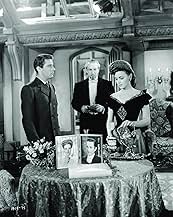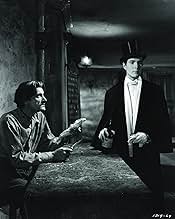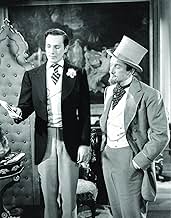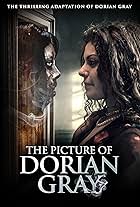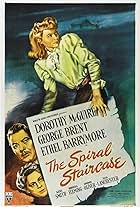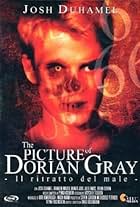Londoner Dorian Gray stays young, but his portrait ages.Londoner Dorian Gray stays young, but his portrait ages.Londoner Dorian Gray stays young, but his portrait ages.
- Won 1 Oscar
- 3 wins & 4 nominations total
Renee Carson
- Young French Woman
- (as Renie Carson)
Lilian Bond
- Kate
- (as Lillian Bond)
Devi Dja
- Lead Dancer
- (as Devi Dja and Her Balinese Dancers)
- Director
- Writers
- All cast & crew
- Production, box office & more at IMDbPro
Featured reviews
This film adaptation of Wilde's story is certainly one of the great atmospheric black and white films of the 40's. Reminiscent of Greg Toland's ground breaking deep focus cinematography in "Citizen Kane",the shades of black, greys and whites are sharp and clearly deliniated to produce an unforgettable, somewhat eerie look to the film. There are a couple of short Technicolor shots that will make you jump. Cinematography is the star here but let's talk about Hurd Hatfield. I have seen this film on numerous occasions and have yet to figure out whether Hatfield is a great actor or just a woodenly inanimate object. Whichever is the case, this is the role of a lifetime.....it calls for an unfeeling, blank-faced characterization which is exactly as Hatfield played it. His smooth unlined visage hides many things and his apparent lack of emoting is right on target. Does that mean that he just couldn't act and fell into a role that suited his style or does it mean that he rose to the task and his interpretation was the sign of a great actor, living the part. I don't know....all I do know is that he pulls it off with great panache! He was playing against one of the great scene stealers of all times, George Sanders, who spouts Wilde epigrams with his own inimitable class and Hatfield holds his own. The other players are adequate but I don't know what all the excitement is about Angela Lansbury's acting....she was much better in "Gaslight". All in all, this is a movie that I would recommend but beware....it moves slowly, very slowly. Once you see it maybe you can answer the question about Hurd Hatfield's acting.....or maybe not!!!
Hurd Hatfield sells his soul so that his portrait ages and reflects his evil while he stays young in "The Picture of Dorian Gray," based on the classic novel by Oscar Wilde. The film also stars George Sanders, Angela Lansbury, Donna Reed, and Peter Lawford. After wishing to stay young forever and falling prey to the words of a cynical friend, Gray goes against what might have been a decent nature and embarks on a vicious life that brings cruelty, sadness, and even death to those with whom he interacts.
The film is striking for several reasons: There is very little of what one would call action; many scenes are quite short; the film relies heavily on narration; the leading man's face remains impassive throughout. This could have been a recipe for disaster, but instead, "The Picture of Dorian Gray" is an extremely compelling film. This sumptuous production is meticulously photographed, with wonderful use of shadows which help create a dark atmosphere. The performances are excellent, particularly those of a very young Angela Lansbury and George Sanders. Peter Lawford and Donna Reed are the beautiful young things who don't have to depend on a portrait for youth.
Hurd Hatfield surely had one of the strangest faces in film - he certainly looked the part of a young, almost pretty Englishman, with his unlined face, high cheekbones, and full lips. As the role dictates, he was appropriately detached and lacking emotion. Six or seven years earlier, this role would have been perfect for Tyrone Power, who would have imbued it with more charm - making the evil inside Dorian all the more difficult to accept among his friends, and thus, his true personality would have seemed more treacherous. Given the way Hatfield played it, I had no problem believing he was capable of anything, and wondered why his friends didn't buy the nasty rumors.
As for the portrait - what a concept. Would that we all had one in our closets. It would put plastic surgeons out of business.
The film is striking for several reasons: There is very little of what one would call action; many scenes are quite short; the film relies heavily on narration; the leading man's face remains impassive throughout. This could have been a recipe for disaster, but instead, "The Picture of Dorian Gray" is an extremely compelling film. This sumptuous production is meticulously photographed, with wonderful use of shadows which help create a dark atmosphere. The performances are excellent, particularly those of a very young Angela Lansbury and George Sanders. Peter Lawford and Donna Reed are the beautiful young things who don't have to depend on a portrait for youth.
Hurd Hatfield surely had one of the strangest faces in film - he certainly looked the part of a young, almost pretty Englishman, with his unlined face, high cheekbones, and full lips. As the role dictates, he was appropriately detached and lacking emotion. Six or seven years earlier, this role would have been perfect for Tyrone Power, who would have imbued it with more charm - making the evil inside Dorian all the more difficult to accept among his friends, and thus, his true personality would have seemed more treacherous. Given the way Hatfield played it, I had no problem believing he was capable of anything, and wondered why his friends didn't buy the nasty rumors.
As for the portrait - what a concept. Would that we all had one in our closets. It would put plastic surgeons out of business.
It's hard to say what it is about "The Picture of Dorian Gray" that I enjoyed so much, but I did like it. Hurd Hatfield at first seems miscast and ineffective as the titular character, but somewhere around the one hour mark, his one and only expression begins to grow on you until you feel just as unnerved by his presence as those who come in contact with him in the story. George Sanders--from what I've seen--played one character his enter career but played it so well, and his performance in this film is no exception. Angela Lansbury is surprisingly sympathetic as the sad and timid singer. The only one in the cast who really doesn't work is Donna Reed. Her character feels tacked on, and she isn't allowed to do much but look faithful and beautiful.
The film is shot wonderfully, and Harry Stradling's cinematography gives the East End scenes a dark, atmospheric counter balance to the rather plain and flat interiors of Dorian's home. The swinging lamp was a nice touch and reminded me of "Psycho"'s finale.
I suppose my only criticism is toward the end, the story introduced one or two characters without giving them proper context or background (I'm thinking of the Allen Campbell character). I'm assuming Dorian "convinces" him to take part in his plans because of some sort past homosexual tryst, but it seemed unfair to bring him in they way he was, have him serve the role he does, and then disappear so quickly without explanation. And speaking of suggested themes: Is it just me, or could you make an argument that Dorian is Jack the Ripper? Maybe it's actually pretty obvious or maybe I'm just interpreting too much into the story, but that's what I got out of it.
P.S. I had the opportunity to see the actual painting from the film during an Ivan Albright exhibit at the Metropolitan Museum of Art in 1997. It's even more gruesome in person.
The film is shot wonderfully, and Harry Stradling's cinematography gives the East End scenes a dark, atmospheric counter balance to the rather plain and flat interiors of Dorian's home. The swinging lamp was a nice touch and reminded me of "Psycho"'s finale.
I suppose my only criticism is toward the end, the story introduced one or two characters without giving them proper context or background (I'm thinking of the Allen Campbell character). I'm assuming Dorian "convinces" him to take part in his plans because of some sort past homosexual tryst, but it seemed unfair to bring him in they way he was, have him serve the role he does, and then disappear so quickly without explanation. And speaking of suggested themes: Is it just me, or could you make an argument that Dorian is Jack the Ripper? Maybe it's actually pretty obvious or maybe I'm just interpreting too much into the story, but that's what I got out of it.
P.S. I had the opportunity to see the actual painting from the film during an Ivan Albright exhibit at the Metropolitan Museum of Art in 1997. It's even more gruesome in person.
Like 'The Importance of Being Earnest', Oscar Wilde's only novel 'The Picture of Dorian Grey' is one of his most famous works for very good reason. It is philosophical essentially in nature, but also very chilling, dripping in atmosphere and full of Wilde's sparkling wit.
This 1945 film adaptation had so much going for it, with the involvement of great actors like George Sanders and Angela Lansbury for one thing. 72 years on, it's still one of the best overall versions of 'The Picture of Dorian Grey' there is/. Surprisingly, for film adaptations of classic literature made in the "classic era" it's pretty faithful, but 'The Picture of Dorian Grey' (1945) is actually even more successful on its own terms.
It may not be flawless, but it comes close. Donna Reed's character feels very tacked on and Reed, despite looking radiant, looks, sounds and acts out of place. Peter Lawford, in an admittedly limited role, spends his entire screen time looking bewildered and like he had little idea what to do with what he had.
Don't on the other hand let the pacing put you off. It is deliberate and measured, but to me it was never dull or too slow. The atmosphere, the performances and Wilde's dialogue were instrumental in making the film compelling and they shine brilliantly.
Visually, 'The Picture of Dorian Grey' (1945) is notably striking. As elegant as the costumes are, how classy and moodily atmospheric the lighting is and how sumptuous the Gothic set design is, it's the outstanding cinematography (that enhances everything so much) that's the star. The music score is resolutely haunting, also with inspired use of Beethoven, Mozart and Chopin, and the direction has immense sophisticated style.
Wilde's writing shines firmly to the fore as one would expect, some great lines that have full impact. Even with more measured pacing, the storytelling is rich in chilling atmosphere and class with the impact of the portrait having a truly startling effect.
All the acting is very strong and one of 'The Picture of Dorian Grey's' best elements. Sanders has the best lines (classic Wilde witticisms and cynical but witty observations) and the most interesting character (like a human Mephistopheles Oscar Wilde-style), and Sanders' performance is very like his Oscar-winning performance in 'All About Eve' five years later, a once in a lifetime role that he was born to play and it is difficult to imagine anybody else deliver those lines the way Sanders did so effortlessly. Lansbury is both chirpy and touching, plus she has rarely looked so young or more beautiful, her rendition of "Good Bye Little Yellow Bird" wrenches the heart also.
Hurd Hartfield's muted performance may be unimpressive or controversial, and it is easy to overlook him in favour of the juicier supporting roles. To me though, the mute inexpressive quality of his acting added quite vastly to the deceptively chilling nature of the role itself. Lowell Gilmore also stands out.
Overall, a near classic and one of the better film adaptations of Wilde's work, if one is looking for elegance, atmosphere and great production values, writing and performances look no further. 9/10 Bethany Cox
This 1945 film adaptation had so much going for it, with the involvement of great actors like George Sanders and Angela Lansbury for one thing. 72 years on, it's still one of the best overall versions of 'The Picture of Dorian Grey' there is/. Surprisingly, for film adaptations of classic literature made in the "classic era" it's pretty faithful, but 'The Picture of Dorian Grey' (1945) is actually even more successful on its own terms.
It may not be flawless, but it comes close. Donna Reed's character feels very tacked on and Reed, despite looking radiant, looks, sounds and acts out of place. Peter Lawford, in an admittedly limited role, spends his entire screen time looking bewildered and like he had little idea what to do with what he had.
Don't on the other hand let the pacing put you off. It is deliberate and measured, but to me it was never dull or too slow. The atmosphere, the performances and Wilde's dialogue were instrumental in making the film compelling and they shine brilliantly.
Visually, 'The Picture of Dorian Grey' (1945) is notably striking. As elegant as the costumes are, how classy and moodily atmospheric the lighting is and how sumptuous the Gothic set design is, it's the outstanding cinematography (that enhances everything so much) that's the star. The music score is resolutely haunting, also with inspired use of Beethoven, Mozart and Chopin, and the direction has immense sophisticated style.
Wilde's writing shines firmly to the fore as one would expect, some great lines that have full impact. Even with more measured pacing, the storytelling is rich in chilling atmosphere and class with the impact of the portrait having a truly startling effect.
All the acting is very strong and one of 'The Picture of Dorian Grey's' best elements. Sanders has the best lines (classic Wilde witticisms and cynical but witty observations) and the most interesting character (like a human Mephistopheles Oscar Wilde-style), and Sanders' performance is very like his Oscar-winning performance in 'All About Eve' five years later, a once in a lifetime role that he was born to play and it is difficult to imagine anybody else deliver those lines the way Sanders did so effortlessly. Lansbury is both chirpy and touching, plus she has rarely looked so young or more beautiful, her rendition of "Good Bye Little Yellow Bird" wrenches the heart also.
Hurd Hartfield's muted performance may be unimpressive or controversial, and it is easy to overlook him in favour of the juicier supporting roles. To me though, the mute inexpressive quality of his acting added quite vastly to the deceptively chilling nature of the role itself. Lowell Gilmore also stands out.
Overall, a near classic and one of the better film adaptations of Wilde's work, if one is looking for elegance, atmosphere and great production values, writing and performances look no further. 9/10 Bethany Cox
The key word for this movie is elegance. The cast move through sumptuous sets with the males dressed in immaculately tailored dress suits and the women exquisitely gowned. It seems that all the aristocrats lived in homes the size of Buckingham palace with high ceilinged rooms and magnificent staircases. They exchange Oscar Wilde epigrams in the cultured tones of the British upper classes.
Some great performances. Hurd Hatfield, an extremely handsome actor with a limited range ,gives the best one of his career as does George Sanders as the cynical Lord Henry Wotton, and a young Angela Lansbury is very moving (especially when she sings "The Little Yellow Bird").
One (very small) criticism. The color shots of the Dorian Gray portrait showing his degradation don't match the high standards of the rest of the design, they look more like pages from a horror comic. I think the producer's, with their obviously high budget, could have used a more imaginative artist.
As I say a small criticism. This a great film of psychological horror.
Some great performances. Hurd Hatfield, an extremely handsome actor with a limited range ,gives the best one of his career as does George Sanders as the cynical Lord Henry Wotton, and a young Angela Lansbury is very moving (especially when she sings "The Little Yellow Bird").
One (very small) criticism. The color shots of the Dorian Gray portrait showing his degradation don't match the high standards of the rest of the design, they look more like pages from a horror comic. I think the producer's, with their obviously high budget, could have used a more imaginative artist.
As I say a small criticism. This a great film of psychological horror.
Storyline
Did you know
- TriviaIn the novel, Sibyl Vane called Dorian Gray "Prince Charming", not "Sir Tristan".
- GoofsAt approximately 34:35 into the film, the time on the clock in the room suddenly changes from just after 2 o'clock to 3 o'clock. Then at approximately 37:00 it moves back to 2:05 and then to 2:09 as Dorian continues to play the piano.
- Quotes
Lord Henry Wotton: "If I could get back my youth, I'd do anything in the world except get up early, take exercise or be respectable."
- Alternate versionsSome prints are slightly edited, omitting Dorian's prayer and Lord Henry's line, "Heaven forgive me" in the final scene.
- ConnectionsFeatured in The Cinematographer (1951)
- SoundtracksGood-Bye, Little Yellow Bird
(uncredited)
Lyrics and Music by C.W. Murphy and William Hargreaves
Performed by Angela Lansbury
Details
- Release date
- Country of origin
- Official site
- Language
- Also known as
- El retrato de Dorian Gray
- Filming locations
- Production company
- See more company credits at IMDbPro
Box office
- Budget
- $3,500,000 (estimated)
- Runtime1 hour 50 minutes
- Color
- Aspect ratio
- 1.37 : 1
Contribute to this page
Suggest an edit or add missing content

Top Gap
By what name was The Picture of Dorian Gray (1945) officially released in India in English?
Answer

